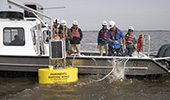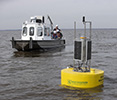Southeastern deploys buoys for monitoring project
Friday, February 2, 2024
by: Tonya Lowentritt
VIDEO CLIPS AVAILABLE: A link to video clips from the deployment is included below. Clips include assembly
of the buoys at SLU Physical Plant, President Wainwright speaking to the students
who are involved in monitoring, and the deployment of one buoy in Lake Maurepas. The
file can be downloaded at the following link:
https://drive.google.com/file/d/1aaIHWO8cf2Xgd3GdiiwmY9U3sZJ8QVF7/view?usp=sharing
CUTLINES
1) BUOY AWAY – Southeastern Louisiana University deployed four buoys in Lake Maurepas Thursday (Feb. 1) for independent, scientific monitoring as part of Air Products’ work on its Louisiana Clean Energy Complex. Scientists will use data captured directly from the lake to closely monitor the ecosystem.
2) BUOY DEPLOYMENT – Members of the buoy deployment team leave the area after the deployment of one of four buoys in Lake Maurepas. Scientists from Southeastern Louisiana University will be monitoring the marine life populations (fishes, crabs, shrimp), as well as the plant life in the surrounding wetlands, and also watching and studying any variations in water quality with data from the buoys.
3) LAKE MAUREPAS ENVIRONMENTAL MONITORING – Scientists from Southeastern Louisiana University will be monitoring the Lake Maurepas ecosystem with data captured from the lake. The buoys are outfitted with sensors to monitor water parameters, including dissolved oxygen, pH, water temperature, and carbon dioxide.
HAMMOND – Southeastern Louisiana University deployed four buoys this week for
the independent, scientific monitoring of the Lake Maurepas ecosystem as part of its
Memorandum of Understanding (MOU) with the Federal Government and with Air Products’
work on its Louisiana Clean Energy Complex.
“These buoys will provide data that the public can trust about the Lake Maurepas
ecosystem since that data is coming directly from the lake itself. Independent monitoring
of the lake is critically important to the community and all those people who live
and work there,” said Louisiana Clean Energy Complex Commercial Executive Director
Danna LeBlanc. “We know Southeastern researchers are the leading experts on Lake Maurepas,
and the Air Products team is proud that they are able to expand their independent
biomonitoring research by using these buoys.”
Southeastern will gather baseline data within the aquatic and wetland realms
prior to the initiation of any future carbon sequestration projects in Lake Maurepas.
An essential component of the project will be extensive environmental monitoring of
the Lake Maurepas region, so that any impacts of the project can be understood and
data be made publicly available.
“This demonstrates the value of our university to the region and nation as leaders
in environmental monitoring,” said Southeastern’s President William Wainwright. “As
carbon capture projects become more frequent, through Southeastern’s leadership in
research, it can demonstrate the environmental scientific needs surrounding those
activities.”
Specifically, the scientists from Southeastern will be monitoring the marine
life populations (fishes, crabs, shrimp), as well as the plant life in the surrounding
wetlands, and also watching and studying any variations in water quality.
Called the Blind, Amite, Tickfaw, and Maurepas buoys, the YSI Bay Buoys were named
based on their geographic positions in the lake.
“The buoys will gather a variety of parameters in real time with data regularly
uploaded to the cloud,” said Director of the Lake Maurepas Monitoring Program Kyle
Piller. “The data will be posted on our project website through the use of easy to
interpret dashboards for each buoy. Each measured parameter has a ‘normal’ range,
and the software has the ability to send alert messages if a particular measured parameter
is out of the normal range. In essence the buoys will be functioning as an early warning
system.”
The buoys are outfitted with sensors to monitor water parameters, including dissolved
oxygen, pH, water temperature, and carbon dioxide, Piller explained. One buoy will
be outfitted with a weather station to measure atmospheric parameters, including wind
speed, air temperature, relative humidity, barometric pressure and precipitation.
“Southeastern will be monitoring all facets of this project involving the lake
to ensure up-to-date data and information are available. We are making all the data
we record available to the public to ensure everyone’s right to know any findings,”
said Dan McCarthy, dean of the College of Science and Technology.
The website to access project data is southeastern.edu/lakemaurepas.









